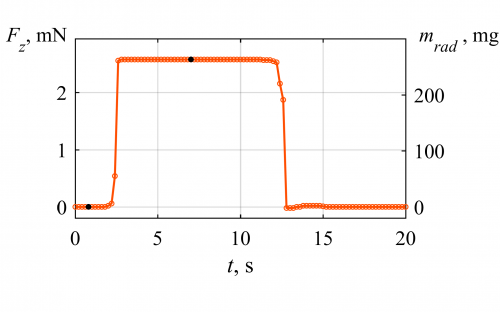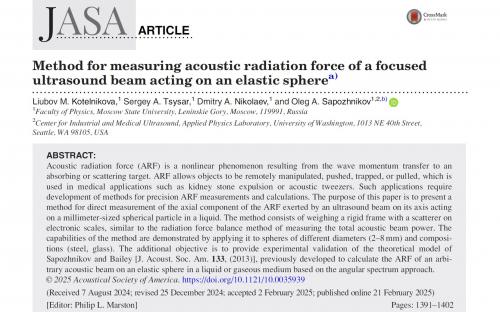Our research on acoustic radiation force measurements has been published in the Journal of the Acoustical Society of America (Q1)
Our paper «Method for measuring acoustic radiation force of a focused ultrasound beam acting on an elastic sphere» has been published in the top-rated journal The Journal of the Acoustical Society of America (Q1, IF 2.1).
Acoustic radiation force (ARF) is a nonlinear wave phenomenon that occurs when momentum of an incident acoustic wave is transmitted to a scattering or absorbing object. The ARF phenomenon is actively used in practical applications of ultrasound, especially in biomedicine: propulsion and directional movement of kidney stones and their fragments in the human body; manipulation of cells, small particles and millimeter-sized objects (e.g., acoustic tweezers); acoustic levitation; elastography (i.e., measuring elasticity of biotissues); biofabrication of constructs from tissue spheroids; etc.
To date, there are many different numerical methods of ARF calculation, in particular, the method of calculation using the beam angular spectrum (SB model), developed with participation of LIMU co-head Oleg A. Sapozhnikov, for the case of an arbitrary ultrasound beam incident on a spherical solid scatterer (sphere). In this paper, numerical calculations were performed with the use of the SB model.
Despite the large amount of theoretical work on ARF calculations (either analytical or numerical), there is far less experimental verification of the calculation methods. The case of a plane wave incident on a spherical scatterer is well developed: in particular, a method of suspending the scatterer on a thread is developed, where the ARF is determined from the angle of deflection of the thread from the equilibrium position. However, for focused beams used in practical applications (e.g., for kidney stone propulsion), this method is no longer suitable due to the strong field inhomogeneity in the focal area. A method for measuring the vertical component of the ARF in focused beams has already been proposed by our laboratory – the "balance method" based on the equilibrium between the radiation force and Archimedes' force (directed vertically upwards) with the force of gravity (directed vertically downwards). However, this method proved to be labor-intensive and lacked the measurement accuracy (up to 10%). In this context, the authors proposed another original method of measuring ARF, the weighting method (*suitable for measuring the vertical component of force only), in which:
- the sphere is fixed in a system of tightly stretched fishing lines;
- fishing lines are attached to a special rigid frame;
- the frame wraps around the tank walls (without touching it) and rests on electronic scales;
- when a signal is applied to the source, the ARF begins to act on the sphere. The magnitude of the ARF is proportional to the reading on the electronic scales;
- the ARF value was measured along the acoustic axis of the source.
This method was described and implemented in the paper to measure the vertical component of the ARF of the focused beam acting on millimeter-sized spheres (2-8 mm) of steel and glass. As a result of this research, it has been shown that:
- the results of the numerical modelling are in good agreement with the results of the experimental ARF measurement (i.e., the SB model calculation method has been verified);
- deviations of the experimental curve from the theoretical one in the form of oscillations (in a function of force versus distance) are caused by the standing waves formation between the surfaces of the scatterer (sphere) and the source;
- a specially selected (using a method also developed in our laboratory) electrical load was used to suppress the amplitude of standing wave oscillations: suppression by a factor of 2 to 4 was achieved;
- in accordance with the theory, the ARF value (measured experimentally) depends linearly on the total acoustic power of the incident beam.
The proposed method was developed similar to the radiation force balance method for measuring the total acoustic beam power. With our method, it is possible to perform ARF measurements with high accuracy: scale accuracy was 40 µN; up to 1% accuracy for measurements in focal area, and up to 10% accuracy for out-of-focus measurements.
For more details – see the text of the paper.








